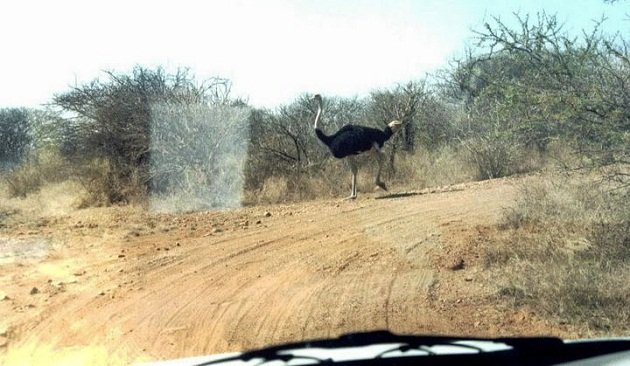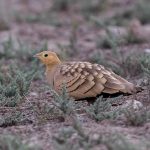
Gaborone, Botswana; June 1999
Marvellous orange-pink sunrise high over the Indian Ocean… Then, landing on a small airport at Gaborone, Botswana. Impossibly bright blue sky. Billboards advertising safari operators in the north of the country. A manicured green lawn in front of the building and an iridescent blue bird on a smallish aloe tree.
 It was June 1999 and I was observing my first ever bird on African soil. It took me a while to ID it. At first, I had no field guide, but even after I obtained it in the souvenir shop of the National Museum, I still wasn’t able to ID it – there were a dozen similarly iridescent starlings in the book. (Statistics would go in favour of the Cape Glossy Starling, as I later learned.)
It was June 1999 and I was observing my first ever bird on African soil. It took me a while to ID it. At first, I had no field guide, but even after I obtained it in the souvenir shop of the National Museum, I still wasn’t able to ID it – there were a dozen similarly iridescent starlings in the book. (Statistics would go in favour of the Cape Glossy Starling, as I later learned.)
The next bird was some crow-like UFO observed from the shuttle bus. Crow-like has to be a crow, doesn’t it? It resembled a Hooded Crow of east Europe, only the grey parts were white – the Pied Crow, as it turned out to be. I asked the bus driver about the bird and he asked me back: “The bi’d?” “Umm, yes, the bird?” “The bi’d…” and he continued with its name in Setswana. One of the peculiarities of the African English is that the “r” is truly silent and practically left to your imagination.
The next one I can remember, going chronologically, was my first sunbird ever – the White-bellied Sunbird in the bush in front of our lodge, opposite the Botswana University. Under that impossibly blue sky of Africa.
The Feral Pigeon and the House Sparrow came the day after, when in the lush green oasis of the Sanitas nursery tea garden I noticed the announcement of the next meeting of the Botswana Bird Club.
Some days later, a new bird came as quite a surprise, an African Pied Wagtail was walking along the sun-scorched pavement in central Gaborone, the area known as The Mall. There were no garden ponds, fountains or any other water sources there and to this day I have no clue what a wagtail was doing there (I also know that it raised an eyebrow in suspicion of my ID, but there are no other similar species around).
 The first BBC outing I joined was some ten days later at the Tsholofelo sewage ponds, a veritable bird bonanza on the outskirts of the city. Some were familiar from my home in the southeast of Europe, such as Squacco Heron and Little Egret; while the others were new and so very African to a newcomer to this continent – Black Headed Heron, Lesser and Greater Flamingoes, Sacred Ibis, then, four ducks – White-faced Duck, South African Shelduck, Spur-winged Goose and the Cape Teal, etc.
The first BBC outing I joined was some ten days later at the Tsholofelo sewage ponds, a veritable bird bonanza on the outskirts of the city. Some were familiar from my home in the southeast of Europe, such as Squacco Heron and Little Egret; while the others were new and so very African to a newcomer to this continent – Black Headed Heron, Lesser and Greater Flamingoes, Sacred Ibis, then, four ducks – White-faced Duck, South African Shelduck, Spur-winged Goose and the Cape Teal, etc.
Waders were represented by Kittlitz’s Plover, Ruff, Wood Sandpiper, Avocet and Black-winged Stilt. When I think of them now, it is a pity I didn’t pay more much deserved attention to waders – it was the opportunity of a lifetime to study them in detail in that glorious sunshine.
On that same day, the Brown-hooded become my first African kingfisher, and on our way out, we paid attention to the cattle entering a fenced area to drink, or, rather, to the Red-billed Oxpeckers on their backs…
First days on a new continent are like going back in time and becoming a beginner once again. Everything around you is new and the World is exciting again, or was it simply Africa?
And, yes, I know. I did use the word “Africa” too many times. I couldn’t help myself – it is such a powerful word!













I love picture of the hornbill. This is so typical. We had one who spent about an hour fighting his reflection in the window of our “tent” each afternoon.
Your description of your first days in Africa matches my own memories. I had a guide book from the beginning, but it was still an adventure for the first couple of weeks just figuring out where in the book I needed to look. Over time it became easier and I had much more success on the second trip last fall.
I had one Southern Yellow-billed Hornbill flying straight into my chalet window in the Khama Rhino Sanctuary, and then remaining spread-eagle for the moment, confused.